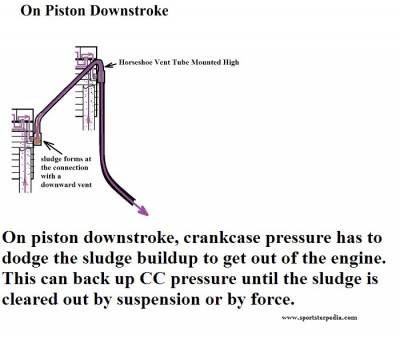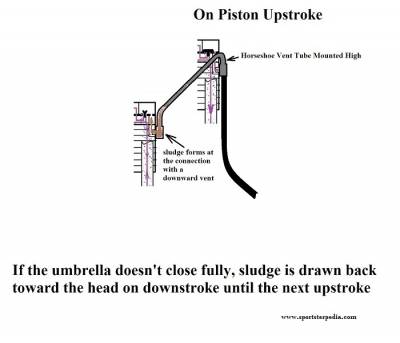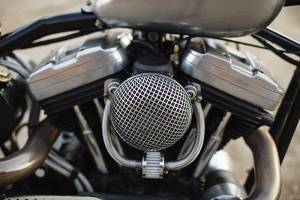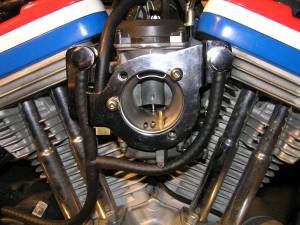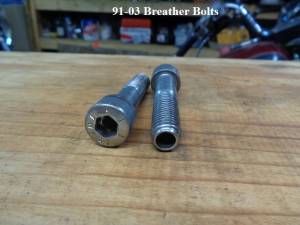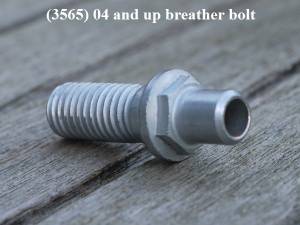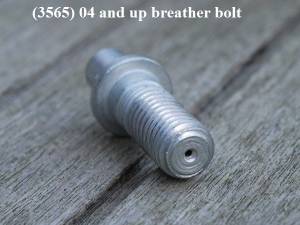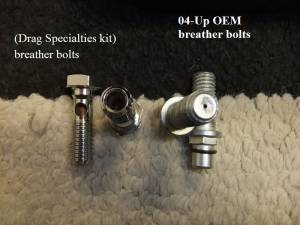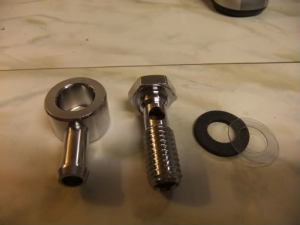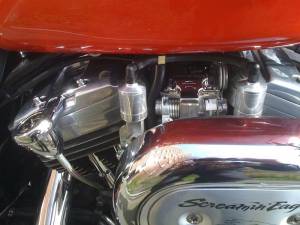Table of Contents
This is an old revision of the document!
REF: Engine Mechanicals
Breather Venting / Relocation
Sub Documents
There are many aftermarket and homemade breather vent relocation mods available to move the vents out of the air cleaner.
Vent Outlet Above vs Below the Head Vents
There has been debatable ways to route the vent lines off the heads when doing air cleaner mods.
However, exact line routing comes down to function over fashion.
While it may look better or cleaner for the lines to be routed above the air cleaner;
Doing so doesn't make for good functioning of the breather system.
The air / oil that gets blown out is a combination of crankcase pressure and engine blowby.
Blowby gasses produce a corrosive vapor which doesn't need to go back into the engine.
It'll simply pool in the heads / vent lines.
As you can see from the drawings below, expelled air leaves the rocker boxes by running downhill to get out the vent holes in the heads.
If the vent lines are piped above the exit point in the heads, oil out of suspension will not drain back into the engine.
The oil would have to run uphill to get from the heads to the rocker boxes and into the lower end.
So there is no functional advantage to running the lines higher than the head vents.
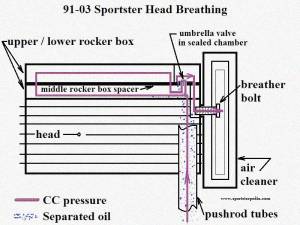 1)
1) 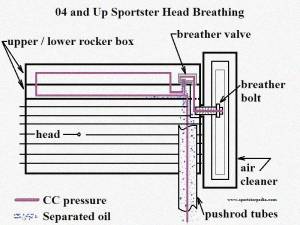 2)
2)
The air coming from the head vents has fine water condensation and oil mist particles in suspension with it.
When that air cools, the oil mist falls out of suspension and collects in the vent lines.
Pointing the vent lines straight into the A/C (OEM) or down into a catch can allows the oil out of suspension to leave the vent lines.
Kuryakyn or Other High Mount Breather Bolts:
However, pointing the vent lines upward of the head vents allows oil out of suspension to collect in them.
Once there is enough liquid oil in the upward breather tubes it will act just like the trap under your sink.
It may block air from getting out until the engine (on startup) builds enough pressure to push the liquid and bubble up to the top.
So it may affect crankcase pressure slightly until the lines are cleared.
Or the trapped oil may simply be blown out the vent lines in globs.
Vent lines mounted high tend to promote a mixture of oil and condensation settling near the head connection of the hose.
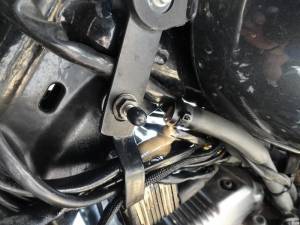 3)
3) 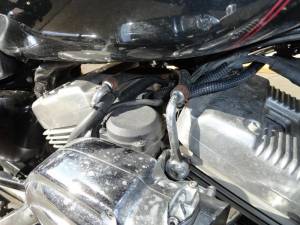 4)
4)
Horseshoe Tube:
The horseshoe breathers that take the outlet from the breather bolts upwards tend to clog with foamy oily gunk. 5)
It's a low pressure output with not enough to push the sludge upwards and around the bend.
This means the breather bolts are swimming in this gunk and if there is a small leak there is plenty to leak.
Fitting a breather where the outlet from the bolts goes downwards alleviates this.
Nylon or copper washers will deform slightly under pressure and seal things better also.
With the horseshoe tube mounted high and only one end with a vent line at the banjo bolt, condensation and oil can emulsify in the non-vented end.
In the pic below, the air in the rear head has to travel up to the front.
When the engine is shut off, condensation / unsuspended oil falls back to the low spot (in this case the tube connection at the rear head).
Goop collects there which either has to re-suspend after startup, heat up and move out into the vent.
If there is a filter on the end of the vent line, this collected goop can be sent to and clog the filter as well.
Some appear to be OK with this as it is seen as better to be outside than inside the engine.
However, the goop (emulsified oil) is a restriction to crankcase pressure leaving the engine until it is cleared.
| Horseshoe tube, high mount / vent line in front. 8) | Rear bolt covered in sludge. 9) | Filter mounted high will receive built up sludge. 10) |
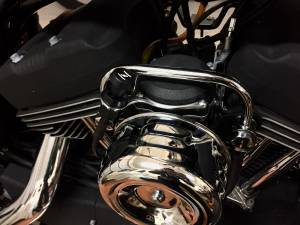 | 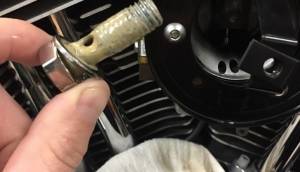 | 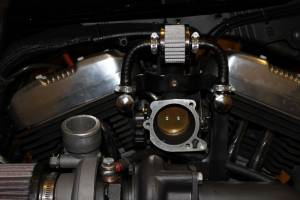 |
Vent lines mounted lower than the head vents allow oil / condensation to leave the heads.
The sludge doesn't get there at once.
To begin with, it's just a slight mist. The restrictions to the vent line (including a filter on the end) allow the mist to glob.
Also, the healthier your engine breathing, the less problems you'll have with the sludge.
But sludge will form even in the healthiest conditions depending on how the vents are routed.
Breather Bolts
OEM Breathe Bolts
Crankcase pressure was increased in 2004 by several means.
One of which was the reduction of the hole size in the breather bolts on the engine side (more restriction).
The smaller hole creates higher pressure in the crankcase on piston downstroke which aides in oil scavenging.
They also allow the air to leave the vents at a faster rate.
The threads in these bolts are cut wider for a tighter fit into the heads.
Aftermarket Banjo Bolts
Aftermarket breather bolts have a larger hole in the bolts than the 04+ bolts.
The banjo bolt must be indexed to have the small side hole on top. 16)
If not, they will drip more. You can adjust them with copper washers.
Careful when tightening the bolts with the holes in the sides, the hole does weaken the bolt.
The threads may be cut to standard width which allows a looser thread fit into the heads.
To stop a leak, you may be tempted to tighten the bolts even more.
This could result in breaking the bolt.
Filter on End of the Vent Line
Lots of folks like to install a small filter on the end of the vent hose. 20)
It's not at all necessary as there is no vacuum there (just a slight escape of crankcase gasses).
The filter adds resistance to the vent pressure coming out of the engine.
This resistance can add to goop in the line / filter later.
Filter Placement
Adding a filter on the end of the line and hanging the filter lower than the vent can cause filter blockage.
No matter what breathing system you are using, a certain amount of oil / air mist still makes it past the breather.
That and vapor condensation will fall out of air suspension when it hits the filter element and cools down.
Even if it's just a small non-visual amount, it will eventually clog in the filter material or in the line before the filter.
Condensation and separated oil and attach to the filter element and clog it up.
If you feel you need a filter on the end, check the the filter routinely to make sure you can blow air through it easily.
Anytime the filter element is not clean looking, there is some amount of debris in it.
The more debris in the filter element, the higher the resistance back to the engine and crankcase positive pressure will be higher.
Too high and it can blow out the seals gaskets in the engine.
Blocking the breather(s) simply bottles up pressure inside the engine.
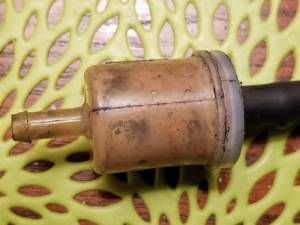 21)
21) 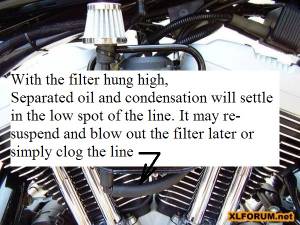 22)
22)

